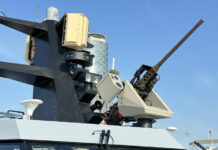Last Wednesday, Prime Minister Ehud Olmert convened an urgent ad-hoc meeting of is security cabinet, to receive an updated assessment of Hezbollah’s rearmament status. It coincided with the second year anniversary of the July 2006 Lebanon War. The military intelligence briefing was far from encouraging.
Damascus is rearming Hezbollah at a rapid pace which is ample proof that the United Nations Security Council Resolution 1701, passed to stop the Second Lebanon War, is on the verge of collapse. In fact it has never really matured into a functioning measure and was virtually ignored by all concerned.
As if to add to its absurdity, only last month, the reliable defense intelligence source Jane’s published some satellite imagery allegedly showing Syrian troops actually deployed on Lebanese territory. Visible in the remote and rugged hills north of the town of Rashaya al-Wadi, close to the Syrian borer, were unidentified troops, believed to be of Syrian origin, in complete defiance of Damascus’ having ended its military occupation of Lebanon back in 2005.
The fact is, well known to Israeli intelligence, that the militant Lebanese Shiite organization is receiving most of its armaments, undisturbed by UNIFIL observation, along the Syrian border, in the northern Beka’a Valley adjacent to Shiite areas under the group’s control.. Linked to Syrian territory by un-patrolled dirt tracks, commercial smugglers are incessantly busy in resupplying equipment and personnel to Hezbollah.
The results are impressive. According to Israeli intelligence assessments, presented to the ministers, the Iranian-backed Shiite militia is now in much better shape than it was on July 12, 2006, when the war started.
Hezbollah has also gained substantial political power in Lebanon itself. In spite of the congratulations that followed the election of Lebanese President Michel Suleiman last May, Nasrallah’s position is more powerful than ever. Many Lebanese fear over what the Shiites may really have in store and that the deal reached in Doha, allowing for Suleiman’s election, does not reflect reality. Analysts agree that Lebanon may have escaped, dangerously spiraling into civil war, but the ultimate price is liable to be, Hezbollah’s long-term de facto control of Lebanon.
Sayyid Hassan Nasrallah is a shrewd operator and knows precisely what he wants to achieve. His major ambition now is Hezbollah’s “liberation” of the disputed Shebaa Farms. By this he wishes to bolster his military posture, making it much stronger than the Lebanese National Army, as his latest show of force in Beirut has clearly demonstrated.
Indeed while some political experts regard Israel’s ceding of the farms to Lebanon as Hezbollah’s final bid, Nasrallah has other ideas. Only last month, he declared that Hezbollah would retain its armed presence even if Israel finally quit the occupied Shebaa Farms district in the south. Even Lebanese are not under any illusion over this claim.
Over the so-called farms, the situation was quite clear. Resolution 425 appeared to close the issue of the Shebaa farms, since the UN Security Council ruled that Israel was in full accordance with this resolution after its May 2000 withdrawal to the international Blue Line border between Israel and Lebanon. Resolution 1310, adopted in 2000, confirmed this. However, strangely, Resolution 1701, meanwhile, adopted after the 2006 Second Lebanon War, implicitly reopened the matter by taking “due note” of Saniora’s seven-point plan, which asks for the Shebaa farms to be placed under UN jurisdiction. Not surprisingly, Hassan Nasrallah quickly seized on the opportunity- this would reopen the disputed area once more to cros-border fighting- Hezbollah style.
In fact there seems a much more sinister goal in Nasrallah’s sights. Even if Olmert should give in to US Secretary Condoleezza Rice’s pressure to discuss the Shebaa farm issue- this will not mean the end of Nasralla’s ambitions. There are already whispers in Beirut, that Nasrallah’s next objective, after Shebaa, will be the “Seven shiite Villages”, which Lebanon claims being on Lebanese territory since 1948. If the Shebaa Farm enigma is a strange one for the uninitiated to behest, the “seven village’ puzzle would seem extraordinary, totally out of focus, even under Middle East circumstances.
Strung along the old 1923 frontier between British Mandate Palestine and French Mandate Lebanon, the Seven Villages, which included more than 25 farms, were annexed to Palestine under the Al-Quds Treaty, creating the mandatory border. No more than a line on a piece of paper, the Sykes-Picot Accord, which established the internationally-recognized frontier between the two colonial mandates, changed nothing for the residents of Jabal Amel, the mountainous region straddling the Lebanese-Palestinian border. After the 1949 armistice, the former residents of the “Seven Villages”, unlike their Palestinian 1948 exodus counterparts were granted Lebanese citizenship in the 1960s, but records of the old land deeds still exist in Sidon and Tyre. But even the most optimistically longing Shiites living in South Lebanon do not share a glimmer of hope, to return to their former homes, perched strategically on the cliffs above the Israeli Galilee Panhandle overlooking the shiny, white Jewish settlements dotting the fertile plain below. But in the fertile mind of Hezbollah leaders like Hassan Nasrallah, the issue of the Seven Villages could well be placed on the back burner, to use, when the time is good and ready to heat another military adventure.
For Nasrallah the motto remains crystal clear: “with one demand filled- there will be others left to fulfill, in his eternal war with the Zionist State”. But whether Hezbollah will slide war tortured Lebanon into another bloody confrontation with Israel, over these highly controversial issues- remains another matter, which will be discussed in Part Two.
















